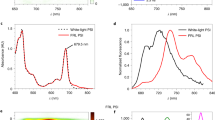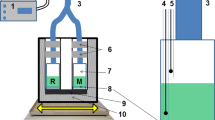Abstract
IT is generally accepted that about four energy quanta of red light (λ = 660 µµ) are needed to promote the assimilation of one molecule of carbon dioxide. This conclusion is based in the main on the measurements of Warburg and Negelein1, who determined the ratio W/E, that is, the volume of carbon dioxide assimilated by Chlorella during the absorption of one calorie of light energy. They designated this ratio by Φ and, since it is well known that Φ increases with decrease in light intensity, the value Φ0 found with the minimum intensity was adopted.
This is a preview of subscription content, access via your institution
Access options
Subscribe to this journal
Receive 51 print issues and online access
$199.00 per year
only $3.90 per issue
Buy this article
- Purchase on Springer Link
- Instant access to full article PDF
Prices may be subject to local taxes which are calculated during checkout
Similar content being viewed by others
References
Z. phys. Chem., 106, 191 (1923).
Biochem. Z., 100, 258 (1919).
Naturwiss., 19, 964 (1931).
Author information
Authors and Affiliations
Rights and permissions
About this article
Cite this article
BALY, E. Quantum Efficiency of Photosynthesis. Nature 149, 218–219 (1942). https://doi.org/10.1038/149218b0
Issue Date:
DOI: https://doi.org/10.1038/149218b0
Comments
By submitting a comment you agree to abide by our Terms and Community Guidelines. If you find something abusive or that does not comply with our terms or guidelines please flag it as inappropriate.



